Module 3 - Benjamin-Mills
Module 3 - Benjamin-Mills
Module 3 - Benjamin-Mills
Create successful ePaper yourself
Turn your PDF publications into a flip-book with our unique Google optimized e-Paper software.
EP2.1<br />
Investigating amines and<br />
amino acids<br />
In this activity you will compare the properties of<br />
amines and amino acids, using butylamine as an<br />
example of an amine and glycine as an example of an<br />
amino acid.<br />
Requirements<br />
● Universal Indicator paper<br />
● test-tubes (8) and rack<br />
● butylamine (2 cm 3 )<br />
● glycine (aminoethanoic acid) (2 g)<br />
● concentrated hydrochloric acid (a few drops)<br />
● sodium hydroxide solution, 2 mol dm –3 (10 cm 3 )<br />
● hydrochloric acid, 0.01 mol dm –3 (1 cm 3 )<br />
● sodium hydroxide solution, 0.01 mol dm –3 (2 cm 3 )<br />
● copper(II) sulphate solution, 0.1 mol dm –3 (2 cm 3 )<br />
● ethanoyl chloride (2 cm 3 )<br />
butylamine<br />
IRRITANT<br />
HIGHLY<br />
FLAMMABLE<br />
ethanoyl chloride<br />
CORROSIVE<br />
HIGHLY<br />
FLAMMABLE<br />
hydrochloric acid<br />
CORROSIVE<br />
sodium hydroxide solution<br />
CORROSIVE<br />
CARE Butylamine and ethanoyl chloride are volatile and<br />
have unpleasant, highly flammable vapours. Use the<br />
bottles in a fume cupboard and avoid inhaling the vapours.<br />
CARE Eye protection<br />
must be worn.<br />
WEAR EYE<br />
PROTECTION<br />
What you do<br />
Carry out the tests in Part 1 on butylamine, an example of an amine. Then carry<br />
out a similar series of tests in Part 2 on glycine, an example of an amino acid.<br />
Before you start, read through the tests and draw up a suitable table in which to<br />
record your observations. Your table should allow you to compare the behaviour<br />
of the two compounds.<br />
Part 1: Reactions of an amine<br />
1 Solubility Add a few drops of butylamine (CARE Highly flammable; irritant<br />
vapour) to 1 cm depth of water in a test-tube.<br />
a Is butylamine soluble in water? Explain any solubility in terms of<br />
interactions between the particles concerned.<br />
b Record the pH of any solution which has been formed. Write an<br />
equation to explain any change to the pH of the water.<br />
2 Adding acid and alkali Add a few drops of concentrated hydrochloric acid<br />
(CARE Corrosive) to the butylamine solution from test 1. Make a note of<br />
any changes, including smell, before and after addition of the acid (CARE<br />
Take very great care when smelling the vapours. Just gently waft your hand<br />
over the mouth of the test-tube towards your nose. Keep your head well<br />
away from the tube. Do this experiment very cautiously.). Then add about<br />
2 cm depth of 2 mol dm –3 sodium hydroxide solution (CARE Corrosive) and<br />
shake the tube gently; again, note any changes.<br />
c<br />
Write equation(s) for any changes you have noted.<br />
3 Reaction with copper(II) sulphate Add a few drops of butylamine to<br />
1 cm depth of copper(II) sulphate solution in a test-tube. Make a note of any<br />
changes which occur.<br />
„ Salters Advanced Chemistry 2000 – see Copyright restrictions<br />
171



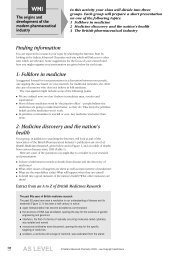
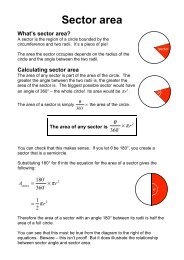
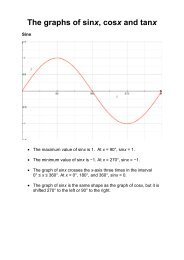
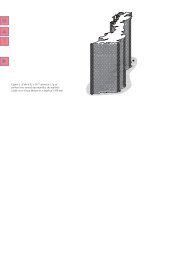

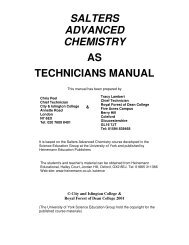



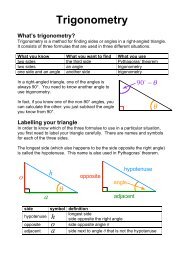
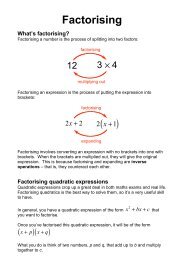
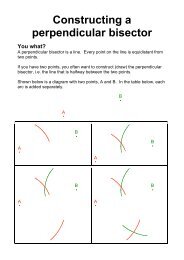

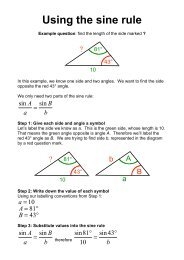
![ISI Web of Knowledge [v.4.10] - All Databases Results - Benjamin-Mills](https://img.yumpu.com/39253071/1/184x260/isi-web-of-knowledge-v410-all-databases-results-benjamin-mills.jpg?quality=85)